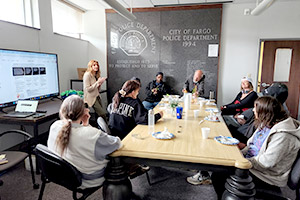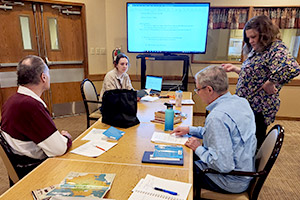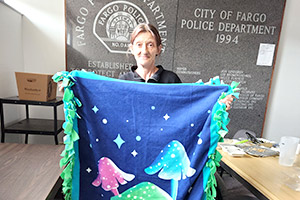Books, Blankets, and Hot Dish
By Jena Pierce on
On a cool rainy afternoon, with the scent of tater tot hot dish in the air (and green beans and rolls), a dozen people sit around a table in a conference room in the old Fargo Police Department building downtown. The building is now the Downtown Engagement Center (DEC), with services offered to those looking for housing, along with harm reduction and other health services.
 Some of
the individuals in the room are unhoused, others are
living in temporary housing in one of several shelters,
and still others are in city-funded apartments for people
living with a mental or physical disability. They all
have one thing in common: they are survivors of a brain
injury. And they are attending a brain injury Lunch and
Learn session, offered weekly in downtown Fargo,
through the North Dakota
Brain Injury Network (NDBIN).
Some of
the individuals in the room are unhoused, others are
living in temporary housing in one of several shelters,
and still others are in city-funded apartments for people
living with a mental or physical disability. They all
have one thing in common: they are survivors of a brain
injury. And they are attending a brain injury Lunch and
Learn session, offered weekly in downtown Fargo,
through the North Dakota
Brain Injury Network (NDBIN).
NDBIN is part of the Center for Rural Health (CRH), housed at the University of North Dakota School of Medicine & Health Sciences. It offers support to individuals with brain injury and their families in an effort to assist them with navigating the health and social service systems post-injury.
A resource facilitator from NDBIN dims the lights. (For those with brain injury, fluorescent lights may be uncomfortable or could trigger a negative response.) This is the person who had invited everyone in the common room at the DEC to come to the Lunch and Learn: a person-centered group to learn about what a brain injury is, what it means to have one, and some strategies to help manage symptoms.
When Is an Injury a Brain Injury?
Not everyone realizes they have a brain injury. Often someone will get hit in the head playing sports as a child, or bump their head in a car accident. Maybe they were in a fight and fell, their head hitting the ground. If they did not go to the hospital, or hear a doctor say the word "brain injury" often they do not realize they sustained a brain injury.

"A brain injury can lead to a vicious cycle," said Shannan Stanke resource facilitator for NDBIN. "Brain injuries can lead to people acting out, changes in temper, substance use, losing housing, and involvement in the criminal justice system. Through our work with the unhoused and those in the prisons and jails, we are seeing the majority of those affected have experienced at least one brain injury throughout their life, and that can lead to a lack of stability. Without resources, support, and treatment, it becomes easy for the cycle to be repeated."
Brain injuries can lead to people acting out, changes in temper, substance use, losing housing, and involvement in the criminal justice system.
Stanke asks people when they may have received their first brain injury and if they have experienced more than one. She lists several potential symptoms, including: difficulty organizing, forgetfulness, and vision and movement problems.
"Once people know what they struggle with," she told the group, "they can share that with doctors or case workers."
The Lunch and Learn sessions allow people to ask questions about their conditions. Some questions participants asked during one session in April were about how multiple sclerosis and brain injury coexist, and how a brain injury can result in post-traumatic stress disorder.
One attendee, Laurie, asked, "When you are not able to talk, how can you tell the difference between a stroke or a brain injury?"
Stanke replied, "A stroke is a brain injury."
A stroke is a brain injury.
Educating people about their disabilities allows them to help advocate for themselves.
At the end of the session, Stanke gave away a door prize – a tie blanket made by members of a book club for survivors of a brain injury in Grand Forks.
Symptoms and Suggestions
Stanke shared information on how nutrition and sleep can help calm the inflammation in the brain and asked the participants what other factors may help relieve symptoms. Many people were excited to shout out an answer (exercise, no alcohol).
Stanke discussed strategies of how to talk to doctors so the patient's concerns are heard. A symptom inventory can provide helpful insight into what symptoms are bothering individuals them most. She has completed several of these with people who attend the Lunch and Learn. They can find out what they struggle with, work through how many injuries they may have sustained, and what type of help they are looking for. NDBIN also has tip sheets available for survivors and providers. These offer tips for dealing with topics such as anger, fatigue, impulsivity/inhibition, and many others.
Alexis, another attendee of the Lunch and Learn, planned to share a tip sheet with her dad to help with their communication. She also credits learning more about her injury with positive changes in her life. "Doing the 'assessment' [referencing the Cognitive Symptom Inventory NDBIN utilizes] has changed my life. Interacting with certain friends of mine, or my psychiatrists, my therapist, my case workers. It helps me when I am having issues, the stressors and emotional dysregulation, and I can read over the tip sheets and I realize what I can do to help in that situation. It gives me a sense of hope."
Words Matter
 That same week, a
book club for survivors of a brain injury was held in
Grand Forks. The small group meets monthly, beginning in
the fall and throughout the spring. They select a book to
read and go through a couple chapters each month. Often a
speech language pathologist student is able to join the
group and work through questions like vocabulary,
meaning, actions that take place in the book, which can
help people who are living with a brain injury.
That same week, a
book club for survivors of a brain injury was held in
Grand Forks. The small group meets monthly, beginning in
the fall and throughout the spring. They select a book to
read and go through a couple chapters each month. Often a
speech language pathologist student is able to join the
group and work through questions like vocabulary,
meaning, actions that take place in the book, which can
help people who are living with a brain injury.
Tom Cariveau, a family medicine doctor, suffered a stroke while he was on duty, over 15 years ago. He was able to notice the symptoms immediately and tried to notify clinic staff, but his speech was already impacted, making it a challenge to communicate. He was able to show that his right arm was not working correctly and immediate treatment saved his life, but his life changed from that day. He recovered physically fairly quickly, though still suffered from expressive aphasia, making speaking difficult.
Cariveau has found that being active in the NDBIN book club, and other group activities, helps with his aphasia and especially strengthening his vocabulary. He speaks in a slow, measured, and thoughtful manner as he reaches for words. But he gets his point across. He looks forward to coming to book club and is still an enthusiastic reader, using his iPad to keep his library of books.

Tom has been a part of a book club for almost a decade, when it was originally organized for survivors of stroke. NDBIN took over the book club more than five years ago. Carly Endres, senior project coordinator for NDBIN, also plans for other activities to occur at the book club meetings.
"Often after a brain injury," Endres said, "attention can be the most impacted area of cognition. To help hold everyone's attention I like to have multiple forms of activities group members can transition to. Making blankets, going for a walk, and crafts are things most utilized. Tie blankets are cost effective and a simple hands-on activity that the majority of our participants can do."
Ties that Bind
Endres, who started the Fargo Lunch and Learn, thought about the unhoused participants in that group and how they sometimes need to sleep in various locations and want to stay warm. The blankets help with that and are age appropriate. Donating the blankets as a door prize, for those who stay through the entire session, made perfect sense. And it was a great way to connect the two groups, who will likely never meet each other, but have experienced similar injuries.
Having a purpose and a place to feel belonging are both basic human needs that are often areas that survivors of brain injury struggle with.
"Having a purpose and a place to feel belonging are both basic human needs that are often areas that survivors of brain injury struggle with," said Endres. "Having both the Lunch and Learn and book club gives our survivors time to interact with other survivors, ask a professional informed on brain injury questions and become aware of new ideas, research, and strategies to help with brain injury symptoms."
Both programs are having a positive outcome in the lives of the people they serve. Stanke handed out little notepads and pens to the Lunch and Learn group so they could write down questions or ways to help with their symptoms that they could refer to. And the lunch provided, along with the blanket door prize, make individuals want to return.
 Laurie, who won
the blanket, said, "I like coming back weekly because you
learn more about how to communicate, and you get to sit
and relax."
Laurie, who won
the blanket, said, "I like coming back weekly because you
learn more about how to communicate, and you get to sit
and relax."
Zach, another attendee who is currently looking for housing, smiled and asked, "What's for lunch next week?" The answer, "Salisbury steak."


 is the communications manager at the Center for Rural
Health at the University of North Dakota School of
Medicine & Health Sciences in Grand Forks.
is the communications manager at the Center for Rural
Health at the University of North Dakota School of
Medicine & Health Sciences in Grand Forks.



